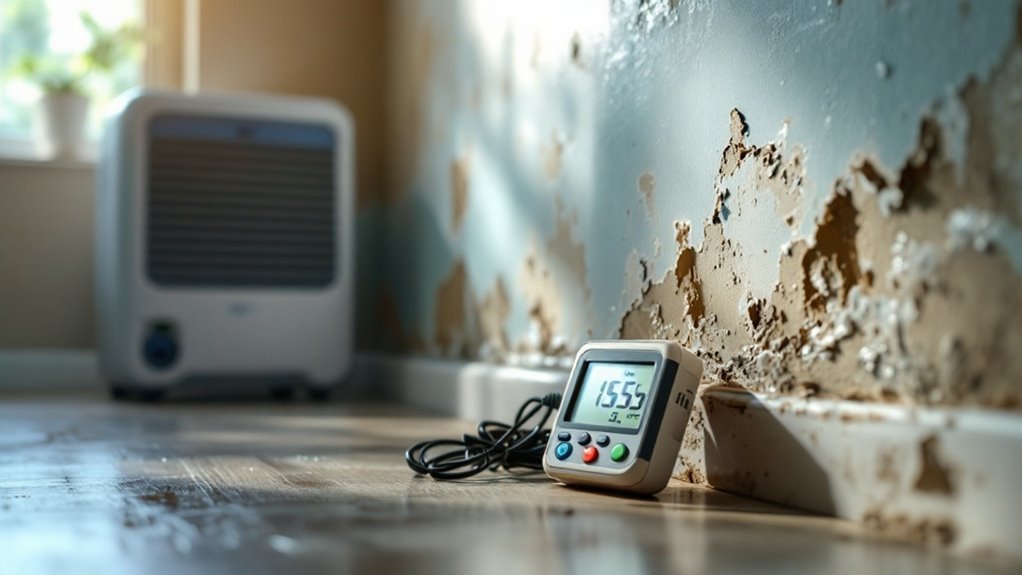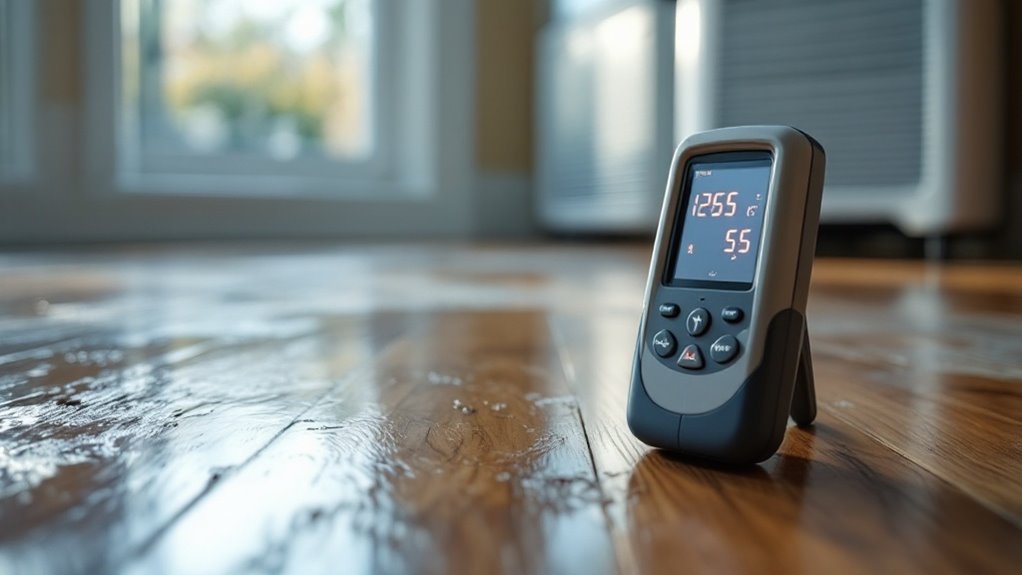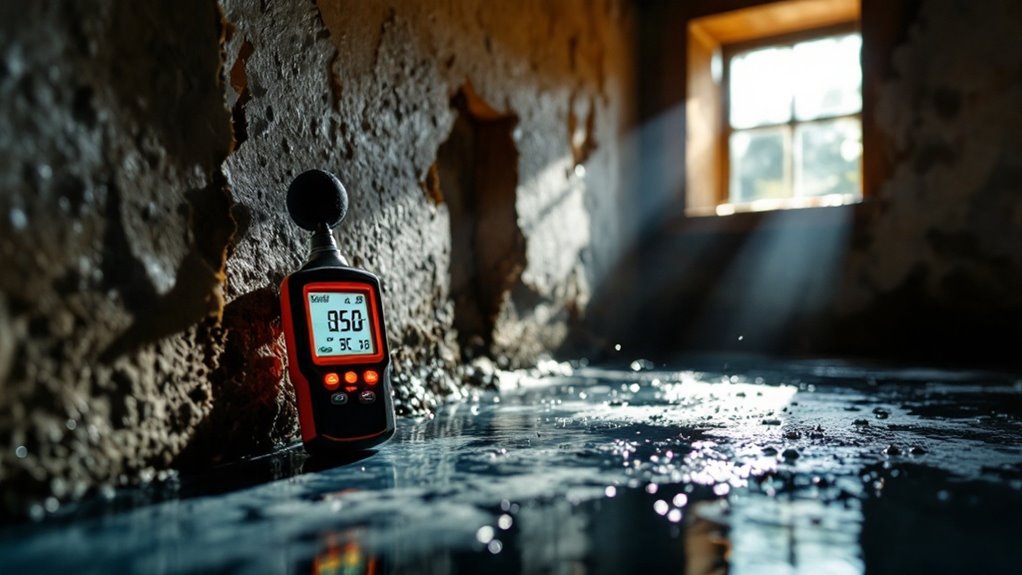Like a ghost lurking in the shadows, moisture can remain hidden long after water damage occurs. You might think everything’s dry, but signs of lingering dampness can haunt your home. To truly assess your space, you’ll need to look for specific indicators and utilize the right tools. Understanding how to identify these signs is vital for your home’s health and safety. So, what should you be on the lookout for?
Key Takeaways
- Inspect for visible water stains, musty odors, and mold growth, as these indicate ongoing moisture issues.
- Use moisture meters to measure moisture levels in walls, floors, and furniture for accurate assessments.
- Check for warped or buckled floors, which can signify hidden dampness beneath the surface.
- Monitor humidity levels with a hygrometer to ensure they remain within a healthy range.
- Consider hiring professionals who utilize advanced tools like infrared cameras for thorough moisture detection.
Understanding Water Damage and Its Effects

When you experience water damage, understanding its effects is vital for your home’s recovery. Water can seep into walls, floors, and furniture, leading to structural issues and harmful mold growth if not addressed promptly. The longer moisture lingers, the greater the risk of damage, which can affect your home’s integrity and air quality. You might notice warping, discoloration, or unpleasant odors as indicators of ongoing moisture problems. Moreover, water can compromise electrical systems, posing safety hazards. It’s imperative to act swiftly and guarantee thorough drying to prevent long-term repercussions. By recognizing these effects, you can take the necessary steps to restore your home and protect your family’s health from potential risks associated with water damage. Additionally, enlisting the help of expert water damage restoration services can ensure a comprehensive assessment and effective mitigation of the issue.
Common Signs of Moisture After Water Damage
After water damage, it’s essential to look for common signs of lingering moisture. You might notice visible water stains on walls or ceilings, which can indicate hidden dampness. Furthermore, if you detect a musty odor, it’s a clear warning that moisture is still present in your home. Regular inspections for hidden mold growth can help catch any problems early before they escalate.
Visible Water Stains
Visible water stains serve as a clear indicator of lingering moisture in your home following water damage. These stains can appear on walls, ceilings, or floors and often vary in color and size. If you spot these marks, it’s essential to investigate further. Here’s a simple table to help you identify common types of water stains:
| Stain Color | Possible Cause | Action Needed |
|---|---|---|
| Yellow/Brown | Leaking roof or plumbing | Inspect roof/plumbing |
| Dark Spots | Mold growth | Check for hidden moisture |
| Clear/Transparent | Recent water exposure | Monitor for drying |
| White/Crispy | Evaporated water | guarantee thorough drying |
| Greenish | Algae or mold | Clean and ventilate |
Addressing these stains promptly can prevent further damage and health issues. Additionally, regular inspections can help identify and mitigate potential moisture problems before they escalate.
Musty Odors Present
A musty odor in your home is often a telltale sign of lingering moisture following water damage. If you notice this unpleasant smell, it’s essential to investigate further. Musty odors usually indicate mold growth or damp materials that haven’t dried completely. Check areas like basements, behind walls, and around plumbing fixtures. Even though you can’t see visible signs of water, the smell can suggest hidden moisture issues. Addressing the source promptly can prevent more serious damage and health risks. Consider using a moisture meter to pinpoint problem areas. If you can’t resolve the issue on your own, don’t hesitate to reach out to professionals who specialize in water damage restoration. Your home’s safety and comfort depend on it.
The Importance of Thorough Drying

Thorough drying is vital for restoring your home after water damage. If you don’t completely dry out your space, you risk structural damage and the growth of mold and mildew. These issues can lead to serious health problems and costly repairs down the line. It’s not just about drying the visible areas; hidden spots like behind walls or under floors need attention too. Even small amounts of moisture can create a breeding ground for harmful bacteria. By ensuring everything is completely dry, you’re protecting your home’s integrity and your family’s health. Don’t underestimate the significance of this step—it’s essential for preventing future issues and ensuring your home remains a safe and comfortable environment.
Tools for Measuring Moisture Levels
To guarantee your home is truly dry after water damage, you’ll need the right tools to measure moisture levels. Moisture meters provide precise readings, while infrared cameras can help you spot hidden dampness. Understanding how to use these tools will give you confidence in your home’s dryness.
Moisture Meters Explained
Moisture meters are essential tools for evaluating water damage and ensuring your home is dry. They help you accurately assess moisture levels in various materials, giving you peace of mind. Here’s what you’ll find when using a moisture meter:
- Digital displays that show precise moisture readings.
- Probes that penetrate surfaces, reaching deep into wood or drywall.
- Audible alerts that signal when moisture exceeds safe levels.
- Calibration options for different materials, ensuring accurate results.
- Compact designs that make them easy to handle and store.
Infrared Cameras Benefits
How can you detect hidden moisture in your home without invasive methods? Infrared cameras offer a powerful solution. By detecting temperature differences, these cameras can reveal moisture that’s otherwise invisible to the naked eye. They help you identify problem areas quickly and accurately, saving you time and money in repairs.
| Benefit | Description |
|---|---|
| Non-Invasive | No need to cut walls or floors. |
| Quick Results | Instant feedback on moisture presence. |
| Visual Representation | Provides clear images for easier analysis. |
Using infrared technology, you can guarantee your home is truly dry, preventing future issues. This tool is crucial for any homeowner dealing with water damage.
Assessing Hidden Areas for Water Retention

Where might water be hiding in your home after damage? It’s essential to check those less obvious areas where moisture can linger. Hidden water can lead to mold and further damage, so don’t overlook these spots:
- Behind drywall: Water can seep through, creating unseen pools.
- Underneath flooring: Moisture can accumulate beneath tiles or carpets.
- Inside cabinetry: Sink leaks can cause water retention in cabinets.
- In crawl spaces: These areas often trap water and humidity.
- Around windows and doors: Gaps may allow water intrusion, leading to hidden dampness.
The Role of Humidity in Drying
Why is humidity such an important factor in the drying process? High humidity levels can greatly slow down the evaporation of water from surfaces in your home. When the air is saturated with moisture, it can’t absorb more, making it harder for damp materials to dry. You might notice that even after using fans and heaters, some areas still feel wet because of increased humidity. To promote effective drying, it’s vital to control humidity levels. You can use dehumidifiers to remove excess moisture from the air, helping create a more favorable environment for drying. Monitoring humidity with a hygrometer can likewise guide you on when to adjust your drying methods, ensuring your home returns to a safe and dry state.
Professional Help: When to Call in Experts
Although many homeowners can handle minor water damage on their own, there are times when calling in professionals is crucial. If you notice any of the following signs, it’s time to seek expert help:
- Persistent damp smells lingering in your home
- Mold growth appearing on walls or ceilings
- Warped or buckled flooring in affected areas
- Excessive humidity levels that won’t decrease
- Water stains that keep reappearing in spite of your efforts
Professionals have the right tools and expertise to assess hidden moisture levels and guarantee thorough drying. Ignoring these signs can lead to bigger problems down the line, so don’t hesitate to reach out when you need assistance. Your home deserves to be safe and dry!
Preventing Future Water Damage
After dealing with water damage, it’s important to take proactive steps to prevent future incidents. Here are some effective strategies you can implement:
| Action | Frequency | Benefit |
|---|---|---|
| Inspect roofing | Biannually | Prevent leaks |
| Clean gutters | Seasonally | Avoid water overflow |
| Check plumbing | Annually | Identify leaks early |
Maintaining a Healthy Home Environment
Maintaining a healthy home environment is vital for your well-being, especially after experiencing water damage. Ensuring your home is free from moisture and potential mold growth is important. Here are some steps to help you create a safe and healthy space:
- Use a dehumidifier to keep humidity levels low.
- Open windows regularly to promote airflow and ventilation.
- Regularly inspect for leaks or signs of moisture in walls and ceilings.
- Clean and replace air filters in your HVAC system.
- Keep indoor plants that naturally purify the air.
Conclusion
To guarantee your home is truly dry after water damage, stay vigilant for signs like musty odors and mold. For instance, imagine you’ve just fixed a leaky pipe, but weeks later, you notice a damp smell in your basement. That’s a red flag! Use moisture meters and check hidden areas to verify everything’s dry. If you’re uncertain, don’t hesitate to call in professionals. A thorough inspection now can save you from costly repairs and health issues later.
